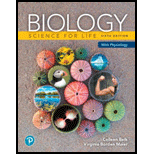
Concept explainers
Support for the endosymbiotic theory for the evolution of eukaryotic groups includes that chloroplasts and mitochondria are surrounded by two membranes, one that derives presumably from the bacterial symbiont and one that derives from the host cell’s vacuole that originally surrounded it. Interestingly, some algal phyla, for instance the Euglenophyta, contain chloroplasts composed of three membranes. Given your understanding of endosymbiosis, how do you think this extra membrane may have evolved?
Want to see the full answer?
Check out a sample textbook solution
Chapter 14 Solutions
Pearson eText Biology: Science for Life with Physiology -- Instant Access (Pearson+)
Additional Science Textbook Solutions
Becker's World of the Cell (9th Edition)
Laboratory Experiments in Microbiology (11th Edition)
Microbiology: Principles and Explorations
Laboratory Experiments in Microbiology (12th Edition) (What's New in Microbiology)
Campbell Biology (10th Edition)
Laboratory Manual for Holes Human Anatomy & Physiology Fetal Pig Version
- a) Describe some characteristics and differences between prokaryotic and eukaryotic cells.b) How do the three domains of life differ from one another?c) Two of the organelles in eukaryotes, the mitochondrion and the chloroplast are believed to haveoriginated through a process of symbiosis. Discuss some of the theories of the origins ofmitochondria and chloroplastsarrow_forwardDescribe the features of mitochondria and chloroplasts that support the endosymbiotic theory.arrow_forwardWhat evidence supports the hypothesis that mitochondria preceded plastids in the evolution of Eukaryotes cells?arrow_forward
- The endosymbiont theory states that mitochondria andchloroplasts evolved from symbiotic relationshipsestablished between bacteria-like cells and theprecursors of eukaryotic cells that engulfed them on what basisarrow_forwardDoes the following phylogenetic tree provide evidence to support or refute the endosymbiosis hypothesis? Briefly explain your choice (1-2 sentences) Bacteria a-Proteobacteria Mitochondria Archaea Eukarya Excavata Discicristata Alveolata Stramenopila Rhizaria Plantae Opisthokonta Amoebozoaarrow_forwardEvidence indicating the chloroplasts were originally free-living prokaryotes that subsequently evolved a symbiotic relationship with a eukaryotic host includes all of the following except: Ability of chloroplasts to synthesize all their own proteins Presence of circular DNA in chloroplasts and in free-living prokaryotes Similarities of rRNA sequences between chloroplasts and free-living prokaryotes Similarities of structures between chloroplasts and some contemporary free-living prokaryotes Carrow_forward
- Under the endosymbiotic theory for the origin of the eukaryotic cell. The ancestor of mitochondria and chloroplasts original became part of mutualism with a larger host cell. Which of the following best explains this mutualism? A) The mitochondria and chloroplasts provided specialized reproduction as part of the proto-germ line while the larger host cell provided energy for growth and reproduction. B) The mitochondria and chloroplasts provided gene products that could be used by the larger host cell for improved parasitization. C) The mitochondria and chloroplasts provided molecular energy in return for protection by the larger host cell. D) The mitochondria and chloroplasts produce toxins that the larger cell utilized to defend itself from other cells mutually increasing the defense of all those involved.arrow_forwardThe theory endosymbiosis is important in understanding how mitochondria and eukaryotic cells may have evolved.what structure is central to the concept of endosymbiosisarrow_forwardAn endosymbiont is any organism that lives within the body or cells of another organism. Each would have performed mutually benefiting functions from their symbirie relationship. Why are the mitochondria considered an endosybiont in an eukaryotic cell ? They have two membranes have DNA sequences that indicate origin from the alpha- prroteobacteria has a means for using oxygen and create ATP can break down glucose for energy O They contain hydrolytic enzymesarrow_forward
- Use this diagram of a Chlamydomonas cell for the following question. M. CY CL is chloroplast, CY is cytoplasm, M is mitochondrion, N is nucleus. Which of the following locations would be the site of translation of genes involved in the process of cellular respiration? 00arrow_forwardThe theory of the endosymbiotic origin of mitochondria and chloroplasts was first proposed by the biologist Lynn Which of the following statements provides support for the theory of endosymbiosis? 1. All the genes found in chloroplasts are homologous to genes found in the nucleus of eukaryotic cell. 2. Mitochondria contain their own ribosomes. 3. Proteins need a targeting sequence to be imported into a chloroplast. 4. Mitochondria can generate a proton gradient and harness it to synthesize ATP. O A. 1, 2 and 3 B. 1 and 3 C. 2 and 4 D. 4 only E. All of 1, 2, 3 and 4 are correct.arrow_forwardWhat types of biological abilities can be combined to create more capable, more complex cells? How does the presecence of different types of ribosomes inside a eukaryotic cell strengthen the endosymbiotic theory? How does chloroplasts and mitochondria found within a cell have two membranes? How does the emergence of endosymbotic theory change the way humans view microorganisms? Will people be comfortable imaginning that the life functions of pants and animals, including their own, are actually dependent on the coexistence of many different microscopic pieces?arrow_forward
 Biology: The Dynamic Science (MindTap Course List)BiologyISBN:9781305389892Author:Peter J. Russell, Paul E. Hertz, Beverly McMillanPublisher:Cengage Learning
Biology: The Dynamic Science (MindTap Course List)BiologyISBN:9781305389892Author:Peter J. Russell, Paul E. Hertz, Beverly McMillanPublisher:Cengage Learning
